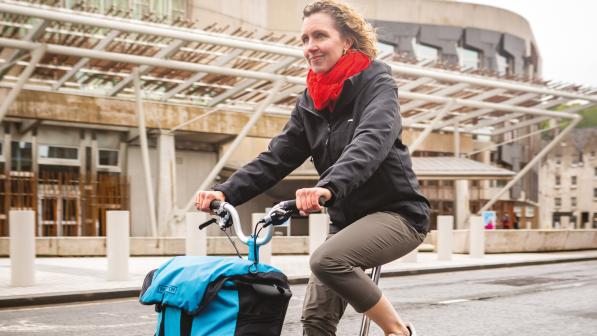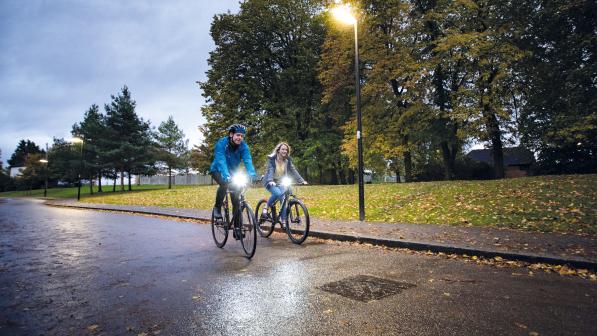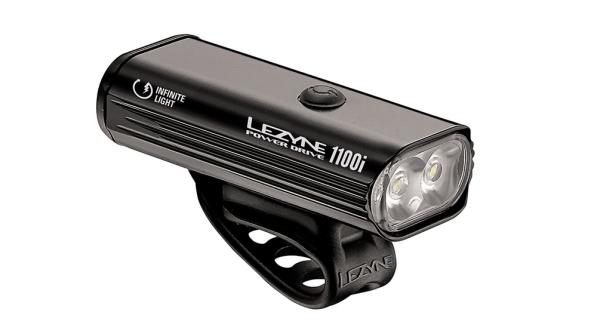Group test: Commuter bike light sets

Bike lights are a practical and legal requirement whenever you’re cycling at night. If you’re riding on country roads or trails, you’ll need a front lamp with a beam bright enough to light your way.
In urban areas where there are streetlights, however, the main role of bike lights is to make you visible to other road users. Because of this, urban commuter lights tend to be cheaper, smaller, lighter and less powerful (fewer lumens) than those designed for use in pitch dark.
While be-seen lights may not illuminate the road ahead, they must alert others to your presence – from as many directions as possible and ideally from a considerable distance. Some will also offer sufficient lumens to ride in full darkness.
Runtimes on be-seen lights tend to be long as they require much less battery power than powerful headlights.
Note that you’re required to use your lights between dusk and dawn, not just when it’s full dark. It makes sense to use them when visibility is limited by poor weather conditions or overcast conditions, although that’s not a legal requirement. Some cyclists also use be-seen lights during daytime, especially on roads with a lot of traffic.
Lezyne Mini Drive 400XL/KTV Drive+
Price: £60
Max lumens: 400 (front), 40 (rear)
Max runtimes: 20hrs (front), 45hrs (rear)
Charge time: NA
Weight: 64g (front), 45g (rear)
Dimensions: 67.8x37.6x27mm (front), 60x41x64mm (rear)
Available from: Upgrade Bikes

The Mini Drive 400XL front light is compact, sturdy and has a sleek metal body. It feels built to last. The mount offers infinite rotation, making it ideal for busy bars and unconventional mounting positions.
Operation is easy, with a button that stands proud and doubles up as a battery-level indicator. For me, eight different modes was overkill.
The rear light has an excellent 270º beam. Day Flash mode offers up to 20 hours of runtime, enough for most commuters. Mounting stability isn’t the best; a deep groove in the rubberised rear means the light tends to slide off centre. It’s well-suited to aero seatposts.
Both front and rear charge via integrated USB, conveniently doing away with cables. Charging via a laptop might be awkward.
Verdict: Good visibility and durability, and an impressive IPX7 rating. The only negative is the rear mounting interface
Trace + TraceR Mk3 ReAKT + Peloton Pack
Price: £110
Max lumens: 125 (front), 120 (rear)
Max runtime: 24hrs
Charge time: 1.5hrs
Weight: 35g
Dimensions: 57mm length, 28mm head diameter
Available from: Exposure Lights

These lights are tiny but effective. Both the flash and steady modes get you seen; the rear really stood out in the group, and side visibility is excellent. The front is definitively a be-seen light.
I found switching between settings took a bit of getting used to, but worth it for the longer runtimes that can be achieved. They can run for up to 24 hours in the lowest setting and only take three hours to recharge. I loved the etchings on the lights themselves, which give runtimes and basic operations.
While these are tiny, they are robust and have an IP67 rating. The hardened plastic clip mount is very secure. They will only attach to round posts and bars unless you buy one of the alternative mounts.
Verdict: High price reflects the quality and functionality of these lights. The rear light is head and shoulders above the others here
Pinnacle USB Multifunction Light Set
Price: £39.99
Max lumens: 300 (front), 5 (rear)
Max runtimes: 20hrs (front), 6hrs (rear)
Charge time: 3.5hrs
Weight: NA
Dimensions: NA
Available from: Evans Cycles

These lights are the cheapest set here, being reduced to just £19.99 at the time of writing. The 300-lumen front light offers three steady modes and two flashing modes, with the lowest steady mode lasting 11 hours and flashing modes five.
The Day Flash mode works particularly well. It has good lateral illumination and an intuitive operation. I found the plastic casing prone to dents and scratches.
The 5-lumen rear has just one mode – steady – lasting five hours, and it’s not very bright. It was also the only one on test without a low battery indicator. The on/off button is easily activated accidentally.
Both mounts incorporate a ratchet rotation, which is useful at the rear for angled seatposts.
Verdict: The front light will get you seen and allow you to see hazards. The rear light feels like a token addition
Busch+Müller Ixon Core 2/IXXI Light Set
Price: £79 approx
Max lux: 70 (front), 12 (rear)
Max runtimes: 18hrs (front), 15hrs (rear)
Charge time: NA
Weight: 125g (front), 35g (rear)
Dimensions: 117x37x44mm (front), 31x31x53mm (rear)
Available from: Busch+Müller

The Core 2 front light is designed to ensure drivers aren’t dazzled, meeting German regulations. There’s no flashing mode, just low, medium and high, lasting from 18 hours on low to 2.5 hours on high. At 70 lux, the high setting is sufficient for riding in the dark, although it’s not as striking in daylight as those that use flash modes.
The battery level indicator is intuitive but not so easy to see in very bright conditions. The light doubles up as a power bank (USB-C port). I love that the battery is replaceable. It has an expected lifetime of seven to nine years before it needs replacing.
The rear IXXI can run for up to 15 hours in a single, steady mode. Side visibility is good, backing up the claimed 320º range. A rubberised body protects against drops and the elements. The beam emitted wasn’t as distinctive as others.
Verdict: A good choice if you don’t want flashing modes. The front light puts sustainability at the forefront
CatEye AMPP 500S and VIS 150
Price: £64.99
Max lumens: 500 (front), 150 (rear)
Max runtimes: 60hrs (front), 70hrs (rear)
Charge time: 4hrs (front), 3hrs (rear)
Weight: 106g (front), 27g (rear)
Dimensions: 36x100.5x38.5mm (front), 62.5x21x32.5mm (rear)
Available from: Cateye Cycling

The plastic casing of the CatEye set looks a bit cheap but performance is excellent. I found it strange that the charging ports were different: USB-C at the front, micro-USB at the rear.
The front light’s daytime mode lasts five hours, basic flash 60 hours. The brightest constant mode is accessible without scrolling, which is handy. Day Flash mode was the most conspicuous of all the lights.
Side visibility is decent. Despite an IPX4 rating, I found the port cover a bit loose. Side visibility of the rear was the best in the group, backing up CatEye’s 360º claim.
It wasn’t the most striking in daylight, though it impressed at night. The mounting bracket is versatile, accommodating any kind of post or tubing. It can even be positioned horizontally.
Verdict: A bit plasticky but the functionality will more than satisfy those riding in both light and dark conditions
Oxford Ultratorch CL500 and Cube-X R25
Price: £39.99 & £14.99
Max lumens: 500 (front), 25 (rear)
Max runtimes: 80hrs (front), 9hrs (rear)
Charge time: 4hrs
Weight: 158g (front), 41g (rear)
Dimensions: 112x36x36mm (front), 40x38x23mm (rear)
Available from: Oxford Products

The CL500 has enough oomph to take you into dark lanes and is easy to use; I loved the scroll forward/backward option. Runtimes were all longer than claimed: 45 hours of Day Flash is impressive. I consistently got more than the claimed one hour on full beam.
The digital display looks great but I found it ‘dropped off’ suddenly, so it’s best to recharge sooner rather than later. The light is well made, feels robust and has an IPX4 rating. It doubles up as a power bank.
The compact rear COB light features both Group Ride and Daytime Hyperflash settings, running 33 and 15 hours respectively. It wasn’t as striking as others but the large surface area throws out plenty of light to get you seen. Side visibility is not as good as some. The mount is shaped for round posts only.
Verdict: Robust lights with some nice features, as well as runtimes that are impressive
Overall verdict
As be-seen lights for urban use, Exposure’s stand well above the others for performance and quality. Their higher price reflects this. The front isn’t sufficient to light your way in the dark, however.
The lights from CatEye, Oxford, Lezyne and Busch+Müller are all up to riding on dark lanes, if this is a requirement. They sit close price-wise and each has its own pros and cons.
I’d say identify your priorities, then buy accordingly. It could be a case of mix and match; several of these lights can be bought separately so you could get front and rear from different manufacturers.
Pinnacle’s front light is inexpensive and impresses in daylight but the rear is disappointing. So although it’s the cheapest set, it may be a false economy.
First published in Cycle magazine, October/November 2025 issue. All information correct at time of publishing.
Cycle magazine
Every two months Cycling UK members receive Cycle magazine, filled with interesting and informative articles, news and reviews for all cyclists.
Members can read the magazine in full online; non-members can read selected highlights.



